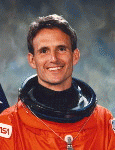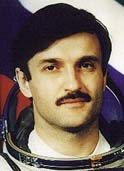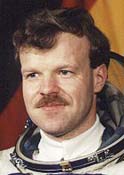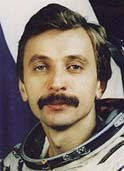
NASA-4 Biographies
| Linenger | Korzun | Kaleri | Tsibliev | Lazutkin | Ewald |
 Jerry
Linenger Biography
Jerry
Linenger Biography
NAME: : J. M. Linenger, M.D., M.S.S.M., M.P.H., Ph.D. (Captain, Medical Corps, USN) NASA Astronaut
PERSONAL DATA: Born January 16, 1955, and raised in Eastpointe, Michigan. Married to the former Kathryn M. Bartmann of Arlington Heights, Illinois. They have two sons. He enjoys competitive triathalons, ocean swim racing, marathons, downhill and cross-country skiing, scuba diving, backpacking, camping. Siblings include Kenneth Linenger, Susan Barry, Karen Brandenburg, and Barbara Vallone, all residing in Michigan. His mother, Frances J. Linenger, resides in Eastpointe, Michigan. His father, Donald W. Linenger, is deceased.
EDUCATION: Graduated from East Detroit High School, Eastpointe, Michigan, in 1973; received a bachelor of science degree in bioscience from the U.S. Naval Academy in 1977; a doctorate in medicine from Wayne State University in 1981; a master of science degree in systems management from University of Southern California in 1988; a master of public health degree in health policy from the University of North Carolina in 1989; a doctor of philosophy degree in epidemiology from the University of North Carolina in 1989.
ORGANIZATIONS: The U.S. Naval Academy, University of Southern California, Wayne State University School of Medicine, and University of North Carolina Alumni Associations; the Association of Naval Aviation; the U. S. Navy Flight Surgeons Association; the Aerospace Medicine Association; the American Medical Association; the American College of Preventive Medicine; the Society of U.S. Navy Preventive Medicine Officers; and the American College of Sports Medicine. Linenger is board certified in preventive medicine.
SPECIAL HONORS: Awarded the Meritorious Unit Commendation; Navy Unit Commendation; National Defense Service Medal; Navy Battle Efficiency Award; Navy Commendation Medal with gold star; and 2 NASA Space Flight Medals. Top graduate, Naval Flight Surgeon Training and Naval Safety Officer's School. Elected to Phi Kappa Phi and Alpha Omega Alpha academic honor societies. Distinguished Alumni Award, Wayne State University School of Medicine. Gihon Award, Society of Naval Preventive Medicine Officers.
EXPERIENCE: Linenger graduated from the U.S. Naval Academy and proceeded directly to medical school. After completing surgical internship training at Balboa Naval Hospital, San Diego, California, and aerospace medicine training at the Naval Aerospace Medical Institute, Pensacola, Florida, he served as a naval flight surgeon at Cubi Point, Republic of the Philippines. He was then assigned as medical advisor to the Commander, Naval Air Forces, U.S. Pacific Fleet, San Diego. After completing doctorate-level training in epidemiology, Linenger returned to San Diego as a research principal investigator at the Naval Health Research Center. He concurrently served as a faculty member at the University of California-San Diego School of Medicine in the Division of Sports Medicine.
NASA EXPERIENCE: Linenger joined astronaut selection Group XIV at the Johnson Space Center in August 1992. He flew on STS-64 (September 9-20, 1994) aboard the Space Shuttle Discovery. Mission highlights included: first use of lasers for environmental research; deployment and retrieval of a solar science satellite; robotic processing of semiconductors; use of an RMS-attached boom for jet thruster research; first untethered spacewalk in 10 years to test a self-rescue jetpack. In completing his first mission, Linenger logged 10 days, 22 hours, 51 minutes in space, completed 177 orbits, and traveled over 4.5 million miles.
Following his first mission, he began training at the Cosmonaut Training Center in Star City, Russia, in preparation for a long-duration stay aboard the Russian Space Station Mir. All training was conducted using the Russian language, and consisted of learning all Mir Space Station systems (life support/electrical/communication/attitude control/computer systems), simulator training, Soyuz launch/return vehicle operations, and spacewalk water tank training. He also trained as chief scientist to conduct the entire US science program, consisting of over one-hundred planned experiments in various disciplines. A sampling includes: medicine (humoral immunity, sleep monitoring, radiation dosimetry), physiology (spatial orientation/performance changes during long duration flight), epidemiology (microbial surface sampling), metallurgy (determination of metal diffusion coefficients), oceanography/geology/limnology/physical science (photographic survey (over 10,000 photos) of the planet), space science (flame propagation), microgravity science (behavior of fluids, critical angle determination).
Linenger launched aboard U.S. Space Shuttle Atlantis (STS-81) on January 12, 1997, remained onboard the space station with two Russian cosmonauts upon undocking of the Shuttle, and eventually returned upon a different mission of Atlantis (STS-84) on May 24, 1997-spending a total of 132 days, 4 hours, 1 minute in space-the longest duration flight of an American male to date. During his stay aboard space station Mir, Linenger became the first American to conduct a spacewalk from a foreign space station and in a non-American made spacesuit.
During the five hour walk, he and his Russian colleague tested for the first time ever the newly designed Orlan-M Russian-built spacesuit, installed the Optical Properties Monitor (OPM) and Benton dosimeter on the outer surface of the station, and retrieved for analysis on Earth numerous externally-mounted material-exposure panels. The three crewmembers also performed a "flyaround" in the Soyuz spacecraft-undocking from one docking port of the station, manually flying to and redocking the capsule at a different location-thus making Linenger the first American to undock from a space station aboard two different spacecraft (U.S. Space Shuttle and Russian Soyuz).
While living aboard the space station , Linenger and his two Russian crewmembers faced numerous difficulties-the most severe fire ever aboard an orbiting spacecraft, failures of onboard systems (oxygen generator, carbon dioxide scrubbing, cooling line loop leaks, communication antenna tracking ability, urine collection and processing facility), a near collision with a resupply cargo ship during a manual docking system test, loss of station electrical power, and loss of attitude control resulting in a slow, uncontrolled "tumble" through space. In spite of these challenges and added demands on their time (in order to carry out the repair work), they still accomplished all mission goals-spacewalk, flyaround, and one-hundred percent of the planned U.S. science experiments.
In completing the nearly five month mission, Linenger logged approximately 50 million miles (the equivalent of over 110 roundtrips to the Moon and back), more than 2000 orbits around the Earth, and traveled at an average speed of 18,000 miles per hour. Because of the flawless launch, docking, undocking, and landing of the Space Shuttle Atlantis (STS-84) crew-exchange mission, he made it back to the planet just in time to be reunited with Kathryn and to witness the birth of their second son.
_______________________________________________________________
| Linenger | Korzun | Kaleri | Tsibliev | Lazutkin | Ewald |
 Valeri
Korzun Biography
Valeri
Korzun Biography
NAME: Valeri Grigorievich Korzun (Colonel, Russian Air Force) Cosmonaut of Yu.A. Gagarin Cosmonaut Training Center
PERSONAL DATA: Born March 5, 1953, in Krasny Sulin. He has a son, Nikita. His father is Korzun Grigori Andreevich, and his mother, Korzun Maria Arsentievna.
EDUCATION: Graduated from Kachin Military Aviation College in 1974; Commander Department of the Gagarin Air Force Academy in 1987. SPECIAL HONORS: Awarded six Air Force Medals.
EXPERIENCE: After graduation from the Military College in 1974, he served as a pilot, a senior pilot, flight section, commander of air squadron in the Air Force. In 1987, he was selected as a cosmonaut for training at the Gagarin Cosmonaut Training Center after successfully graduating from the Gagarin Military Air-Force Academy.
Starting December 1987 through June 1989, he took the course of General Space Training. Korzun was certified as a Test-Cosmonaut in 1989.
From September 1989 through September 1992, he trained for space flight as part of the test-cosmonauts group. From October 1992 to March 1994, he took a training course for flight onboard the spacecraft "Soyuz TM" as commander of the rescue vehicle. From March 1994 to June 1995, he trained as a group member for flight onboard the orbital complex "Mir".
March 1994 through January 1995, he served as a deputy Director of the 27KC crew training complex flight as supervisor of communication with the crew.
Korzun is a 1st class military pilot. He has logged 1473 hours, and has flown 4 types of aircrafts. He is an Instructor of Parachute Training, and has completed 377 parachute jumps.
June 1995 through August 1996, he completed training as a flight engineer for the Mir-22/ NASA-3 and "Cassiopia" (sponsored by CNES) programs.
August 17, 1996 through March 2, 1997, he completed a 197-day flight onboard the Mir station. The program included joint flights with NASA 2, 3 and 4 astronauts, a French astronaut and a German astronaut.
Korzun performed 2 space walks totaling 12 hours and 33 minutes.
_______________________________________________________________
| Linenger | Korzun | Kaleri | Tsibliev | Lazutkin | Ewald |
 Alexander
Kaleri Biography
Alexander
Kaleri Biography
Alexander Kaleri was the flight engineer of the Mir-22 mission, which lasted from August 18, 1996, until March 2, 1997. He and Mir-22 Commander Valeri Korzun worked with two American astronauts on the space station, beginning with Shannon Lucid. Lucid's mission began with the launch of the Space Shuttle Atlantis on March 22, 1996, and ended when she returned to Earth on September 26, 1996. She was replaced by John Blaha, whose mission started with the launch of the Space Shuttle Atlantis on September 16, 1996, and came to a close when he returned to Earth on January 22, 1997.
Kaleri was born May 13, 1956 in Yurmala,Latvia. He is married with one child.
Kaleri was selected as cosmonaut on February 15, 1984
He graduated from Moscow Physics-technical Institute with a diploma in aeronautics and astronautics in 1979 and worked with NPO Engergia.
_______________________________________________________________
| Linenger | Korzun | Kaleri | Tsibliev | Lazutkin | Ewald |
 Reinhold
Ewald Biography
Reinhold
Ewald Biography
Personal Data: Born December 18, 1956 in Mönchengladbach, Germany. He is married and has three children.
Education: Received a Bachelor of Science degree in Physics from the University of Cologne in 1977 and a Master of Science degree in Experimental Physics in 1983. He graduated in 1986 with a PhD in Physics and a minor degree in human physiology.
Organizations: Member of the Deutsche Physikalische Gesellschaft (German Physics Society) and the Association of Space Explorers.
Special Honors: Reinhold Ewald received the Russian "Order of Friendship" in 1992 and the Russian "Medal for Personal Courage" in 1997, awarded by President Yeltsin of the Russian Federation. He was awarded the German Federal Cross of Merit (First Class) in 1997.
Experience From 1983 to 1987: Reinhold Ewald was a research scientist with the University of Cologne on a Deutsche Forschungsgemeinschaft (German academic research federation) research project to assemble and exploit a three-metre radiotelescope installed at the Gornergrat Observatory at an altitude of 3100 metres in the High Alps, near Zermatt, Switzerland. His research topics were the structure and dynamics of interstellar molecular clouds, which are thought to be the birthplace of new stars.
In 1987 Ewald joined DLR (German Aerospace Centre). He managed several projects in extraterrestrial science, including an airborne stratospheric observatory called SOFIA, and various experiments launched on sounding rockets from ESRANGE/Sweden. He then became the coordinator for spaceflight in DLRs planning department.
In 1990 he joined the German national astronaut team and took up training for the German-Russian MIR92 mission at the Cosmonaut Training Centre (TsPK) in Star City, Russia. As the back-up astronaut for the flight (March17-25, 1992), he served as Crew Interface Coordinator at the Russian mission control center (TsUP) in Kaliningrad, providing communications between the crew in orbit and the project management and scientists on the ground. After the mission, he returned to Germany as the Deputy Head of DLRs Astronaut Office and supported the D-2/Spacelab mission onboard the U.S. Space Shuttle (STS-55, April-May 1993).
In 1993 Ewald was appointed Assistant to the Director of DLRs Space Program. In this capacity he was responsible for extraterrestrial, spaceflight and microgravity programs. In 1995 he returned to Star City, Russia, to train for the second German-Russian mission Mir 97.
Since 1998 Reinhold Ewald has also been lecturing part-time on spaceflight operations at the Technical University of Munich. In February 1999 he joined ESAs European Astronaut Corps at the European Astronaut Center EAC in Cologne, Germany.
Spaceflight Experience: Mir 97 was the second German-Russian mission onboard Mir (February 10 to March 2, 1997). Ewald flew as a research cosmonaut on the Russian Soyuz-TM 25 vehicle and spent 18 days onboard the Mir Space Station. He performed experiments in biomedical and material sciences and carried out operational tests in preparation for the International Space Station. He returned on Soyuz-TM 24.
_______________________________________________________________
| Linenger | Korzun | Kaleri | Tsibliev | Lazutkin | Ewald |
 Vasily
Tsibliev Biography
Vasily
Tsibliev Biography
Vasily Tsibliev was the commander of the Mir-23 mission, which lasted from February 10, 1997, until August 14, 1997. He and Mir-23 Flight Engineer Aleksandr Lazutkin worked with two American astronauts on the space station, beginning with Jerry Linenger. Linenger's mission began with the launch of the Space Shuttle Atlantis on January 12, 1997, and ended when he returned to Earth on May 24, 1997. He was replaced by Michael Foale, whose mission started with the launch of the Space Shuttle Atlantis on May 15, 1997, and came to a close when he returned to Earth on October 6, 1997.
Tsibliev was born February 20, 1954 in Orekhovka, Krim Oblash, Ukraine. He is married with two children.
He was selected to be a pilot cosmonaut on March 26, 1987 and retired on June 19 1998.
Tsibliev graduated from Kharkov Military School of Aviation in 1975 from Gagarin Air Force Academy. He acheived the rank of Lieutenant Colonel in the Russian Air Force and resigned from active duty on December 25, 1997.
As of May 2000 he was the First Deputy Commander at the Gagarin Cosmonaut Training Center.
_______________________________________________________________
| Linenger | Korzun | Kaleri | Tsibliev | Lazutkin | Ewald |
 Aleksandr
Lazutkin Biography
Aleksandr
Lazutkin Biography
Aleksandr Lazutkin was the flight engineer of the Mir-23 mission, which lasted from February 10, 1997, until August 14, 1997. He and Mir-23 Commander Vasily Tsibliev worked with two American astronauts on the space station, beginning with Jerry Linenger. Linenger's mission began with the launch of the Space Shuttle Atlantis on January 12, 1997, and ended when he returned to Earth on May 24, 1997. He was replaced by Michael Foale, whose mission started with the launch of the Space Shuttle Atlantis on May 15, 1997, and came to a close when he returned to Earth on October 6, 1997.
Lazutkin was born October 30, 1957 in Moscow, Russia. He is married with two children.
He was selected to be a cosmonat on March 3, 1992 and became a flight engineer. Lazutkin graduated from Moscow Aviation Institute with a mechanical engineering degree and he worked with NPO Energia.